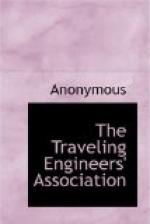14. Q. Is air necessary for combustion?
A. Yes.
15. Q. About how many cubic feet of air is necessary for the combustion of a pound of coal in a locomotive fire-box?
A. About 300 cubic feet of air must pass through the grates and fire for complete combustion of one pound of coal.
16. Q. Why must air be heated before combining with coal?
A. Air, like coal and its gases, must be heated before they will unite to form what is known as combustion and so as not to reduce the temperature of the fire-box below the igniting point of the gases.
17. Q. Why is it necessary to provide for combustion a supply of air through the fuel in the furnace?
A. In order to supply the oxygen necessary for combustion.
18. Q. What is the effect upon combustion if too little air is supplied? If too much air is supplied?
A. If too little air is supplied, combustion is not complete, and only one-third as much heat is obtained. If too much air is supplied, combustion is complete; but the excess air must be heated, resulting in a lower temperature. If twice the amount of air required for complete combustion be supplied, the temperature of the fire-box will be about one-half as high.
19. Q. Give a practical definition of the igniting temperature.
A. In all ordinary combustion there is a definite temperature, called the ignition or kindling temperature, to which combustible substance must be heated in order that it may unite with the gas in supporting the combustion. The burning substance must not only be heated up to the kindling temperature, but it must be kept as high as this temperature, or combustion will cease.
20. Q. State why such temperature is necessary and at what place in the fire-box it is most required.
A. The center is the hottest part of the fire-box. There is a much lower temperature in the fire-box at the sides and end sheets, due to the water on the opposite sides of the sheets being of a lower temperature than the fire-box; therefore if we get as high a temperature as possible at the side and end sheets, we will increase the steam-making efficiency of the boiler. The gases which are liberated from the coal as soon as it becomes heated must attain a temperature of about 1,800 degrees Fahrenheit, known as the “temperature of ignition,” before they will unite with air which must also be heated up to that point.
21. Q. How is draft created through the fire?
A. Exhaust steam escaping through the stack reduces the pressure in the smoke-box below the pressure of the atmosphere outside, therefore the air tends to force itself into the smoke-box through all openings; with everything in good condition, the easiest and largest passage for it is through the grates and other openings into the fire-box and from it through the tubes into the smoke-box and up the stack.
22. Q. Is smokeless firing practicable?




